Plan checklist
The Nickerson Property
1135 North Portage Road, Lake of Bays
Planting plan created by The District Municipality of Muskoka
Funded by •


Schedule A:
Plants & Property
Land Characteristics
This planting plan is designed based on the land characteristics identified during the day of the site visit. Plants are chosen according to the soil and light conditions on your property. The number of plants chosen for each planting compartment takes into account the square metre area of the space, as well as the amount of current vegetation cover. Your property is part of ecoZone: 4b
Land Characteristics by Compartment
| Length | Width | Area | pH | Soil | Moisture | Light | Height | |
|---|---|---|---|---|---|---|---|---|
| A | 7.8m | 5.6m | 43.7m2 | acidic | sandy, loamy | moist | partial sun, shade | |
| B | 13.3m | 5m | 66.5m2 | acidic | sandy | normal | partial sun | |
| C | 4.8m | 2.2m | 10.6m2 | acidic | sandy | normal | partial sun | max 2m |
| D | 4.5m | 2m | 9m2 | acidic | sandy, loamy | normal | partial sun, shade | max 2m |
| E | 4m | 2.5m | 10m2 | acidic | sandy | normal | partial sun | max 3m |
| F | 6.7m | 6.9m | 46.2m2 | acidic | sandy | normal, moist | full sun | |
| G | 14.3m | 6.3m | 90.1m2 | acidic | sandy | normal | full sun | |
| 55.4m | 4.36m | 276.1m2 |
Plant Selection Summary
The following shrubs and trees are chosen for their suitability and survivability given the current soil and light conditions in each compartment on your property, as well as preferable features.
| Plant Species | A | B | C | D | E | F | G | Potted | Bareroot | Wildflower |
|---|---|---|---|---|---|---|---|---|---|---|
| Buttonbush | 2 | 2 | ||||||||
| Silky Dogwood | 4 | 4 | ||||||||
| Silver Maple | 1 | 1 | ||||||||
| Witch Hazel | 3 | 1 | 4 | |||||||
| Ostrich Fern | 15 | 12 | 6 | 9 | 42 | |||||
| Swamp Milkweed | 6 | 6 | ||||||||
| Spotted Joe-Pye Weed | 12 | 12 | ||||||||
| Virginia Creeper | 1 | 1 | ||||||||
| Red Osier Dogwood | 4 | 2 | 2 | 5 | 1 | 14 | ||||
| Ninebark | 3 | 3 | ||||||||
| Canadian Serviceberry | 2 | 2 | ||||||||
| Fragrant Sumac | 6 | 3 | 6 | 15 | ||||||
| Black Cherry | 1 | 1 | ||||||||
| Bearberry | 18 | 11 | 29 | |||||||
| Bush Honeysuckle | 2 | 3 | 6 | 5 | 16 | |||||
| New Jersey Tea | 2 | 6 | 1 | 9 | ||||||
| Wild Columbine | 6 | 10 | 16 | |||||||
| Wintergreen | 9 | 9 | ||||||||
| Alternate-Leaved Dogwood | 2 | 2 | ||||||||
| Purple Coneflower | 6 | 6 | ||||||||
| Black-Eyed Susan | 9 | 3 | 12 | |||||||
| Oswego Tea (Red Bergamot) | 6 | 3 | 9 | |||||||
| Wild Bergamot | 3 | 3 | 6 | |||||||
| Showy Mountain-Ash | 1 | 1 | ||||||||
| Snowberry | 3 | 3 | ||||||||
| Saskatoon Serviceberry | 2 | 2 | ||||||||
| Eastern Red Cedar | 1 | 1 | ||||||||
| Fly Honeysuckle | 1 | 1 | ||||||||
| Big bluestem or Turkey foot | 3 | 3 | ||||||||
| Butterfly Milkweed | 3 | 3 | ||||||||
| Dense Blazing Star | 3 | 3 | ||||||||
| Sweet Oxeye | 2 | 2 | ||||||||
| Yarrow | 3 | 3 | ||||||||
| Subtotal | 44 | 47 | 19 | 40 | 28 | 33 | 32 | 81 | 0 | 162 |
| Totals | 243 | |||||||||
Plant Information
The following table summarizes key information about each plant selected for your property.
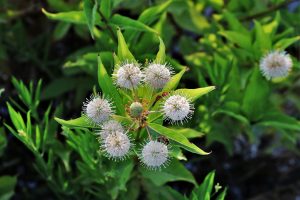
|
ButtonbushHeight: 2 m
Buttonbush is a small to medium-sized deciduous shrub species which typically grows about 2 m in height. This plant may also be known by the common name Button Willow. Twigs are slender to stout and dark red-brown in colour with white speckling. The leaves are bright green coloured, shiny, ovate shaped, oppositely arranged, and have entire margins. The flowers are tiny, tubular, white, fragrant, and appear densely on distinctive, spherical clusters in June. These flowers turn into a dense cluster of seeds, which remain on the plant throughout the winter. The flowers are beneficial for pollinator species, including hummingbirds and butterflies. This is a hardy, adaptable species and an excellent choice for planting on wet shoreline sites.
|
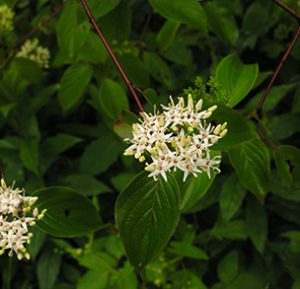
|
Silky DogwoodHeight: 2-4m
The Silky Dogwood is a large, deciduous shrub species native to Eastern North America that reaches a height of 2-4m. This species produces a rounded shape due to its numerous upright branches stemming from a central, multi-stemmed base. Branches which grow touching the ground can develop their own root system, often creating thickets. During the spring and summer, branches are a shiny, light green colour and change to a red colour during the fall and winter. This species produces simple, lance-shaped leaves arranged oppositely along the branches. During the spring and summer, the foliage is a deep green colour and turns dark red-purple during the fall prior to dropping. Small, yellow-white flowers bloom during mid-June, maturing into bright blue berries in September. This species of Dogwood grows best alongside Willow when being planted to mitigate erosion and stabilize shorelines.
|
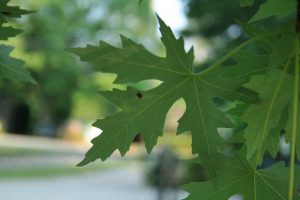
|
Silver MapleHeight: 30m
The Silver Maple is a fast growing, deciduous Maple tree famous for its majestic, mature form. This species has a broad, round crown that sits on top of a tall straight trunk reaching 30m in height. Its ascending branches give this tree a full, bushy appearance. Silver Maple leaves can be differentiated from other Maple leaves due to the deep notches on their lobes. It has a silvery white colour on its underside in contrast to bright, light green topside. During the fall, the leaves on the Silver Maple turn a reddish orange to bright golden yellow. Between late April and May, inconspicuous, small greenish red flowers bloom and by June turn to yellowish-green or brownish pairs of winged keys. The Silver Maple's shallow, spreading root system and ability to withstand flood and drought make it an excellent tree to utilize for erosion control and shoreline stabilization.
|
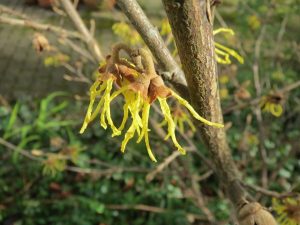
|
Witch HazelHeight: 4-9m
The Witch Hazel is a deciduous understory shrub, with a broad and rounded crown which typically grows 5-9m. This species can sometimes take on the form of a tree. Witch Hazel is most recognizable for its 2 cm long, spidery, bright yellow flowers, which bloom during late fall. Leaves produced are alternate, simple, 6-15 cm in length, and obovately shaped. These leaves are dark green on top with paler undersides and turn yellow during the autumn. Witch Hazel leaves produce hairs on their principal veins, are asymmetrical at their base, scalloped, and sometimes coarsely toothed. In addition, the leaves contain 5-7 straight, parallel, ascending veins per side. The twigs are slender, zigzagged, tawny, and smooth when mature. Witch Hazel fruiting bodies are short, thick, light brown capsules that become woody upon maturation. This species is typically multi-stemmed with two or more trunks, which are crooked and 10-15 cm in diameter.
|
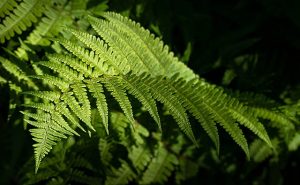
|
Ostrich FernHeight: 1.5 m
The Ostrich Fern is a coarse, erect to arching perennial fern, that can grow up to 1.5 m in height. The stems are clustered and arching while the leaves are ostrich-plume shaped, widest near top, and very gradually narrowed to the base. The size of the leaves grow up to 1.5 m long and 12-40 cm wide, with around 40 pairs of leaflets or pinnae. The leaflets are long, narrow-pointed, and ascending. The leaves are fertile, with spore clusters on the undersides of sub-leaflets.
|
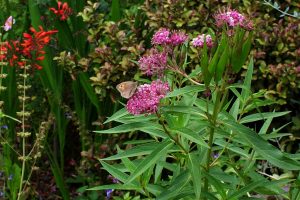
|
Swamp MilkweedHeight: 1 m
Swamp Milkweed is a beautiful wildflower species that typically grows about 1 m tall. The leaves are light green coloured, narrow, lance shaped, and oppositely arranged. The flowers are showy, fragrant, bright pink, appear in clusters on flowering stems, and bloom between July and August. The flowers give way to large, long and narrow, brown seed pods, which produce an abundance of seeds with tufts of long, white hairs. The flowers are beneficial to pollinator species, like bees and butterflies. As with all Milkweeds, the stem exudes a milky sap when broken, however the sap of the Swamp Milkweed is less milky than other species. This sap is critical for caterpillars of the endangered Monarch Butterfly to deter predators.
|
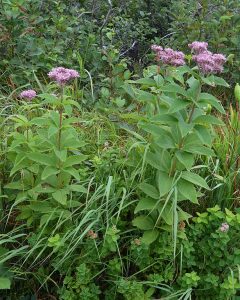
|
Spotted Joe-Pye WeedHeight: 1.5 m
Spotted Joe-Pye Weed is a colourful wildflower species that can grow up to 1.5 m tall and can spread about 1 m. It has a plain or spotted purple stem, which is sometimes covered in fine hairs. The leaves are large, lanceolate shaped, have serrated edges, and appear in whorls of 3-5. The flowers are showy, fragrant, bright pink/purple coloured, have 8-20 disk florets, appear in clusters at the top of a flowering stem, and bloom in mid to late summer. The flowers are beneficial to pollinator species, like bees and butterflies. This plant spreads well and can form small colonies. The roots can be useful for controlling erosion and stabilizing shorelines.
|
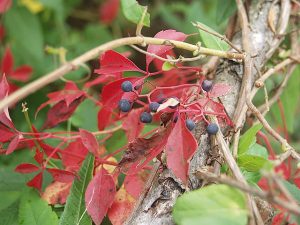
|
Virginia CreeperHeight: 15 m
The Virginia Creeper is a deciduous, woody vine species which can grow up to 15 m if near a tall structure or tree. The leaves are palmately compound with five ovate shaped leaflets. These leaves are largely toothed and turn bright red and orange during the fall. Despite having inconspicuous flowers, this species produces incredible dark blue berries, which are beneficial to birds and small mammals. This vine can grow 2-3 m per growing season, thus pruning and maintenance may be required. Virginia Creeper may sometimes be confused with Poison Ivy as younger plants will only have three leaflets instead of five. This plant can grow aggressively so should be planted where it has plenty of space to spread. Some shoreline landowners choose to plant this around rip rap/loose stone retaining walls for a more natural appearance. The root system is beneficial for quickly controlling erosion.
|
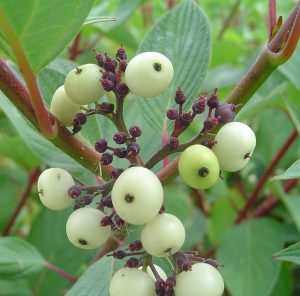
|
Red Osier DogwoodHeight: 1.5-4m
The Red Osier Dogwood is a medium-sized, deciduous shrub native throughout Northern and Western North America which typically grows to 1.5-4m. This species is multi-stemmed with numerous erect and ascending bright red branches that create a loose and spreading form. Leaves produced are simple, two-toned with a dark green upper side and light green underside. They are arranged opposite each other along the branches. During the fall, the foliage turns a brilliant red to dark purple. Clusters of small, creamy white flowers form on the terminal ends of the branches between June and July. The Red Osier Dogwood produces blueish-white fruiting bodies during late summer, which may persist throughout the winter. This shrub's berries provide an important winter food source for numerous species, from large deer to small wintering birds.
|
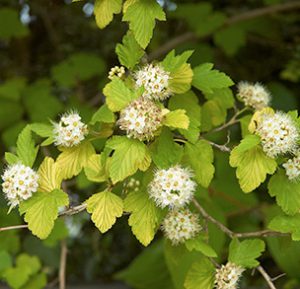
|
NinebarkHeight: 2-3m
The Common Ninebark is a very hardy, large (2-3m in height), deciduous shrub naturally occurring within riparian zones. This species is often planted as an ornamental shrub for its exfoliating bark which reveals reddish-light brown inner bark. This shrub is multi-stemmed with numerous horizontal and ascending branches creating a full, round shape. The Common Ninebark produces dull green, ovate to round shaped leaves with three to five lobes per leaf. During the fall the leaves turn brilliant yellow or dark purple. Between May and June, showy, bell-shaped flowers bloom in clusters on the terminal ends of the branches. During the summer, these flowers give way to small green or green-yellow berries which turn a bright red upon ripening.
|
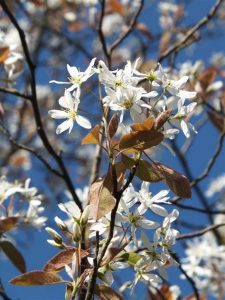
|
Canadian ServiceberryHeight: 3-5 m
The Canadian Serviceberry is a multi-stemmed shrub or small tree which grows from 3-5 m in a dense round form. This plant may also be known by the common names: Juneberry, Shadblow, or Shadbush. Early in the spring, prior to leaf development, clusters of fragrant, showy white flowers bloom along the branches. By July, these flowers give way to the fruiting bodies. The fruits are initially small, green berries, which grow to the size of blueberries and turn a deep purple-blue upon maturation during the fall. Leaves produced are finely toothed and spear-shaped. Throughout the summer, leaves are dark green and turn a dramatic orange-red during the fall.
|
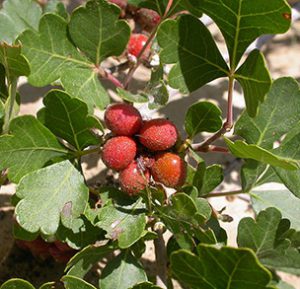
|
Fragrant SumacHeight: 1-2m
The Fragrant Sumac is a medium-sized deciduous shrub within the Cashew family. This species grows between 1-2 meters in height, is multi-stemmed, and produces a round, dense crown composed of erect and spreading branches. Between March and April, small yellow flower clusters bloom on the terminal ends of the branches prior to leaf development. Fruit development begins during late summer. Small, red, hairy berries are produced and can remain on the plant throughout the winter. Male catkins develop on the plant in September. Fragrant Sumac leaves are simple and arranged alternately along the branch. Leaves produced are simple and trifoliate with a large center lobe, appearing similar to Poison Ivy. During the spring and summer, the leaves are light green to green-yellow in colour turning a bright yellow to red or dark purple in autumn. Crushed leaves and stems of the Fragrant Sumac produce a fragrant citrus aroma, hence the common name. The aroma of this shrub is attractive to butterfly species, making it the perfect addition to any butterfly garden. The roots of the Fragrant Sumac are shallow, fibrous, and spread rapidly, making it an ideal choice for stabilizing shorelines and mitigating erosion on steep slopes. Unlike other Sumac species, Fragrant Sumac is significantly less aggressive and easily maintained.
|
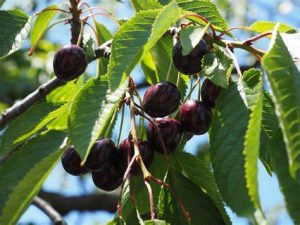
|
Black CherryHeight: 20-30m
The Black Cherry is a medium-sized deciduous tree typically 20-30m in height and can tolerate a wide variety of light, soil and moisture conditions. This species is native to North America. The Black Cherry is commonly found in mixed, broad-leafed forests. This cherry species produces a slender trunk and a narrow, irregular crown with arching branches and drooping tips. Leaves are simple and grow alternately along the branch. Small, white flower clusters appear in May and turn to reddish cherries during early summer and ripen by late August. These cherries provide a food source for songbirds and small mammals. Black Cherry Roots are shallow and wide-spreading.
|
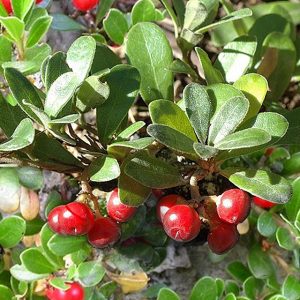
|
BearberryHeight: 20 cm
Bearberry is a low growing, evergreen shrub/ground cover species that grows about 20 cm tall. The leaves are dark green, leathery, shiny, ovate shaped, alternately arranged, and have entire margins. The flowers are tiny, urn shaped, white to pink colored, appear in drooping clusters, and bloom between April and May. Flowers are followed by bright red berries, which remain throughout the fall and winter. These berries are beneficial to wildlife species like birds and small mammals.
|
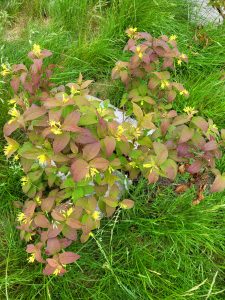
|
Bush HoneysuckleHeight: 1m
The Bush Honeysuckle is a small, hardy, deciduous shrub that rarely grows taller than 1 m in height. The leaves are simple, oppositely arranged, ovate shaped, and have finely toothed margins. During the spring and summer, the leaves are dark green in colour, then in the fall they take on a variety of colours ranging from a deep purple to light yellow. The flowers are small, showy, yellow to orange colored, trumpet shaped, appear in clusters on the tips of branches, and bloom between June and July. The flowers are beneficial to pollinator species, including hummingbirds and butterflies. The roots of the Bush Honeysuckle are fibrous, giving it the ability to form thickets and making it an ideal shrub to plant for erosion control.
|
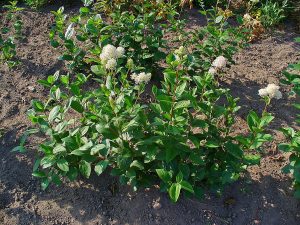
|
New Jersey TeaHeight: 1-1.5 m
New Jersey Tea is a short, hardy, deciduous shrub species that typically grows between 1 and 1.5 m in height. This plant may also be known by the common names: Red Root, Indian Tea, or Wild Snowball. The leaves are alternately arranged, broad, ovate shaped, dark to medium green colored, have toothed margins, and have hairy undersides. The flowers are tiny, white colored, fragrant, appear in clusters on flowering stalks, and bloom between May and July. The flowers are beneficial for pollinator species, like butterflies and hummingbirds. The root system is thick and deep making the plant drought tolerant and valuable for erosion control.
|
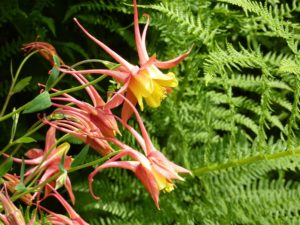
|
Wild ColumbineHeight: 0.5 m
Wild Columbine is a perennial wildflower that grows about 0.5 m tall and is popular among gardeners due to its beautiful red and yellow coloured flowers. These flowers are nodding flowers, meaning that they droop downwards off the end of the branch. They have five sepals and five petals that stretch upwards creating five long spurs out the back. The leaves are attractive, compound and made up of 9-27 leaflets, appear in groups of three, and are rounded or broadly egg-shaped with rounded lobes. The sweet nectar of this wildflower is a great attractant to hummingbirds and butterflies.
|
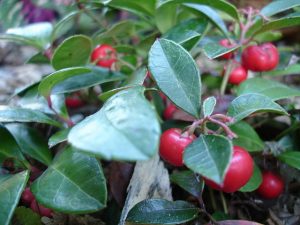
|
WintergreenHeight: 15 cm
Wintergreen is a medium-sized ground cover species that grows up to 15 cm in height. The leaves are glossy, dark-green, simple, oval shaped, and turn purple during the fall. Wintergreen is a visually appealing plant that produces small, white, bell-shaped flowers during the spring. This species yields edible, scarlet red berries during July, which persist throughout the winter months. These berries are a great food source for many song birds, squirrels, deer and a tasty treat for humans when added to pastries or salads. The name Wintergreen comes from the plants ability to keep it's leaves throughout the winter. Wintergreen is unique because their leaves emit a minty aroma when crushed. Wintergreen oil is commonly used in the flavoring of gum and toothpaste.
|
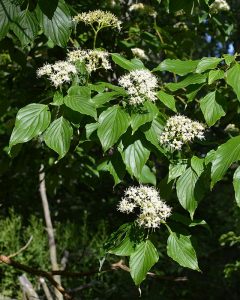
|
Alternate-Leaved DogwoodHeight: 5-10 m
The Alternate-Leaved Dogwood is a tall, deciduous shrub or small tree species that can grow 5-10 m in height. This plant may also be known by the common name Pagoda Dogwood. It can be grown either in the form of a single stem tree or multi-stemmed shrub comprised of two or three smaller trunks. The leaves are ovate shaped, alternately arranged, have prominent veins, have a pointed tip, and have entire margins. The flowers are showy, fragrant, whitish yellow, appear in flat clusters, and bloom between May and June. These flowers produce clusters of dark blue berries. The flowers are beneficial for pollinator species while the berries are beneficial for wildlife species. The root system is valuable for controlling erosion and stabilizing loose soil. This plant is often used as a small ornamental tree in landscaping. The common name comes from the fact that all other Dogwood species have oppositely arranged leaves.
|
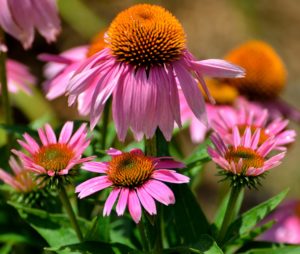
|
Purple ConeflowerHeight: 1m
Purple Coneflower is a perennial wildflower that typically grows about 1 m tall. This plant may also be known by the common name Echinacea. The leaves are dark green coloured, alternately arranged, lance shaped with pointed tips, and have serrated margins. The flowers are showy, pale purple to pink, have 15-20 toothed petals, appear atop erect stems, and bloom between June and August. This wildflower spreads well and can be used to naturalize un-vegetated areas. The roots can be useful for controlling erosion and stabilizing shorelines. This flower blooms for long periods. The flowers are beneficial to pollinator species, like bees and butterflies. The seeds are also beneficial to wildlife species, like birds and small mammals.
|
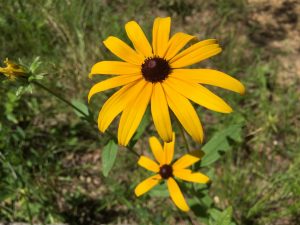
|
Black-Eyed SusanHeight: 1 m
Black-Eyed Susan is a popular biennial or a short-lived perennial wildflower species that typically grows about 1 m in height. Its leaves are green, alternately arranged, lance shaped, and covered with bristly hairs giving the leaf a grey/green colour. The flowers are daisy-like, have 8-20 yellow ray florets surrounding numerous dark brown disk florets, and blooms between June and September. The flowers are beneficial to pollinator species, like bees and butterflies. The seeds are also beneficial to wildlife species, like birds and small mammals. This flower blooms for long periods.
|
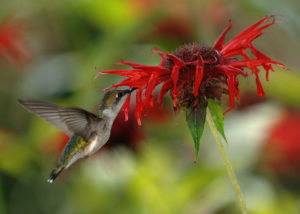
|
Oswego Tea (Red Bergamot)Height: 50 cm
Oswego Tea is a showy perennial wildflower species that typically grows about 50 cm in height. This plant may also be known by the common names Red Bergamot or Scarlet Beebalm. The leaves are dark green, oval shaped, have a minty fragrance. The unique flowers are bright red and grow in dense rounded clusters, with individual tubular flowers that bloom between May and October. The beautiful flowers of Oswego Tea attract various pollinator species like hummingbirds, butterflies, and bees. The Oswego Tea plant is susceptible to a common fungal disease, called powdery mildew, when planted in dry soils. Historically, the leaves of the plant have been used for antiseptic purposes, as well as poultices to heal minor wounds and skin infections.
|
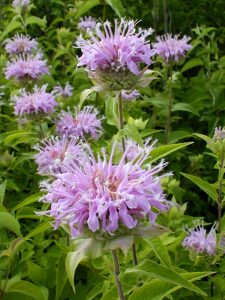
|
Wild BergamotHeight: 1 m
Wild Bergamot is a perennial wildflower species that is member of the mint family and can grow about 1 m tall. Its stems are light green and smooth with abundant branching on the upper half. The leaves are oppositely arranged, broadly lanceolate shaped, 6-10 cm long, and have toothed edges. The also leaves emit a aromatic minty/oregano scent when crushed. The flowers are showy, pink/lavender coloured, appear on the ends of flowering stems, and bloom between July and September. The flowers bloom in the center of the head first, moving outwards creating a wreath. The flowers are beneficial to pollinator species, like bees and butterflies. This wildflower spreads well and can be used to naturalize un-vegetated areas. The roots can be useful for controlling erosion and stabilizing shorelines.
|
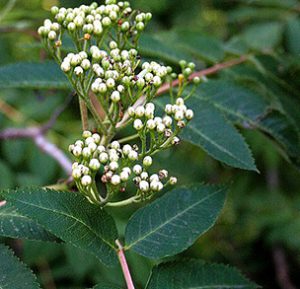
|
Showy Mountain-AshHeight: 15m
The Showy Mountain Ash is a fast growing, deciduous tree which is often planted as an ornamental due to its colourful flowers and berries. This species grows from a straight, narrow, branchless trunk that gives way to a narrow crown, reaching a height of 15m. The bark can be greyish-green or golden-brown and turns scaly with age. As the tree ages, the crown spreads and opens to a more rounded form. Leaves produced are compound with 13-17 leaflets arranged alternately along the branches. Leaves are a vibrant light green and the narrowly elliptical leaflets have tapered tips and fine teeth from tip to middle. During the fall, the foliage turns bright yellow to red. Early in the spring, showy, white flowers bloom in clusters on the terminal ends of branches. They produce large clusters of red berries that remain on the tree throughout the winter. These berries provide an important winter food source for overwintering birds and mammals.
|
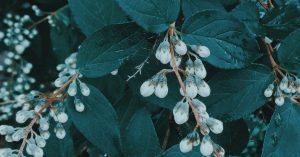
|
SnowberryHeight: 1-2m
The Snowberry is a small shrub known for its white berries bunching at the nodes. This species produces oval-shaped, oppositely arranged, dark green colored leaves with smooth margins on short stalks. The shrub grows 1-2m in height. This shrub yields white to pink clusters of bell-shaped flowers during the summer. The fruiting bodies produced by this shrub are small, white berries that grow in bunches. These berries provide a good food source to a variety of animals, but are poisonous to humans. Snowberry is an ideal species for bank stabilization applications because its roots are vigorous and deep ranging. .
|
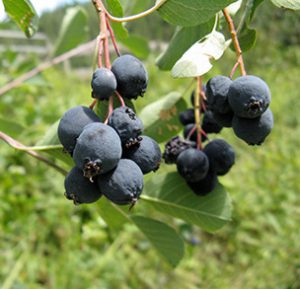
|
Saskatoon ServiceberryHeight: 5m
The Saskatoon Serviceberry is a very hardy, deciduous shrub, which grows numerous lateral and ascending branches giving it a full, rounded shape reaching heights of 5m. Early during the spring, slender pink buds open into small five-petaled flower clusters on the terminal ends of the branches. The flowers open prior to the leaf bud development, turning the plant into a showy, white bush. Over the summer months, the flowers develop into small, pea-sized purple berries. Leaves produced are blue-green, oval-shaped, toothed prominently along the top of the leaf, and arranged alternately along the branches. During autumn, the foliage changes to yellowish-orange or a deep red-purple colour. The Saskatoon Serviceberry is an ideal species to stabilize banks, control erosion, and restore natural areas due to its fibrous root system.
|
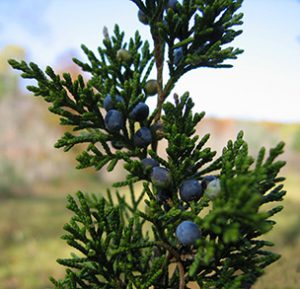
|
Eastern Red CedarHeight: 10-15m
The Eastern Red Cedar is a medium-large sized tree species which produces scale-like evergreen leaves on mature trees that grow to 10-15m. The leaves are needles and are blue-green colored, paired, and grow tight to the twig. This tree's twigs are light green to reddish-brown, slender, and four-sided. Eastern Red Cedar is a dioecious species with separate male and female trees. Male trees produce yellow cones that are 3 mm long, while females produce berry-like cones that are 3-6 mm round, deep blue, and covered in a whitish powder. These berry-like fruits ripen at the beginning of autumn, and are a valuable food source for birds and small mammals. The Eastern Red Cedar produces a single trunk covered in bark, which is brown-grey and exfoliates into strips. This species is branched near the base, produces a conical to cylindrical crown, and has a root system that is fibrous and moderately deep. This tree species is long lived and can reach 150-350 years old.
|
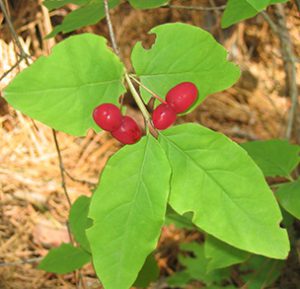
|
Fly HoneysuckleHeight: 1-2m
The Fly Honeysuckle is a medium-sized deciduous shrub that typically grows between 1-2m, and is naturally found throughout Ontario, Quebec, and Eastern Canada. This perennial shrub is multi-stemmed with thin, woody branches and can be grown so that it resembles a vine species. The Fly Honeysuckle's leaves are light green, simple, and oppositely arranged. Leaves are oval in shape and hairless, except at the margins where fine hairs are visible. This species produces flowers which are bell-shaped, white to yellow in colour, drooping in pairs of two, and bloom during late spring. Flowers give rise to large red-orange berries during late summer, which are a favorite to many songbird species.
|
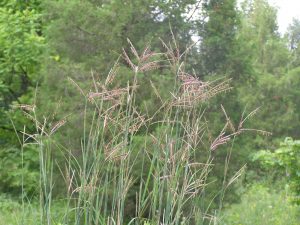
|
Big bluestem or Turkey footHeight: 2 m
Big Bluestem is a perennial, ornamental grass species that typically grows less than 2 m in height. This plant may also be known by the common name Turkey foot. The leaves are gray to bluish green in the spring, have reddish tinges in the summer, and change bronzish lavender in the fall. The flowers are purplish, three pronged resembling a turkey foot, appear in finger like clusters on tall stems, and bloom between September and February. Big Bluestem is easy to grow and is low maintenance. This plant spreads well and can form small colonies. The roots can useful for controlling erosion and stabilizing shorelines. The seeds are also beneficial to wildlife species, like birds and small mammals.
|
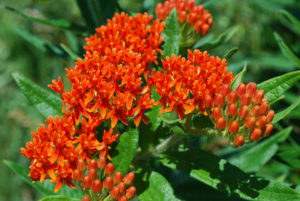
|
Butterfly MilkweedHeight: 0.5 m
Butterfly Milkweed is a very attractive perennial wildflower that typically grows about 0.5 m tall. This plant may also be known by the common name Showy Milkweed. The leaves are green coloured, alternately arranged, narrow and lance-shaped, and have entire margins. The flowers are showy, fragrant, bright orange coloured, have five tiny petals, appear in clusters of 8-25, and bloom between June and August. Butterfly Milkweed is easy to grow and is low maintenance. This wildflower spreads well and can be used to naturalize un-vegetated areas. The roots can be useful for controlling erosion and stabilizing shorelines. The flowers are beneficial to pollinator species, like bees and butterflies. It is also a larval host for caterpillars of the endangered Monarch Butterfly, thus planting this species where possible can help protect this at risk species.
|
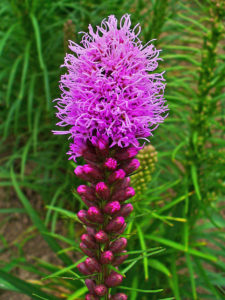
|
Dense Blazing StarHeight: 30-150 cm
Dense Blazing Star is a tall clump-forming perennial wildflower species that can grow up to 150 cm. It has an erect central stem (no branching) that is smooth and purplish/green with many grass-like leaves circulating alternately around it. The leaves are long, narrow, and hairy with one noticeable central vein. This plant is very noticeable when in bloom as it has a wand-like spike of purplish/pink flowers at the top of the central stem. The flowers consist of 4-10 disk florets with a tubular corolla that opens up to 5 spreading star-like lobes and a deeply split protruding style. It prefers moist, well-drained areas such as meadows, moist fields, and along river of lake shorelines. It attracts lots of butterflies and pollinators, as well as mammals such as deer and rabbits. Unfortunately, Dense Blazing Star is listed as threatened under SARA in Ontario. It's main threat is habitat loss due to urban development and habitat alteration. It only naturally occurs in southwestern Ontario with 11-13 known populations. Therefore, this is a great species to plant in suitable areas in Ontario to help protect a threatened species.
|
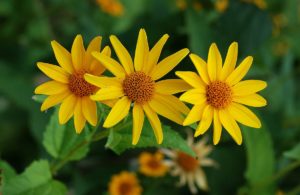
|
Sweet OxeyeHeight: 2m
Sweet Oxeye, also known as False Sunflower, is an attractive, herbaceous, perennial wildflower, which can grow to almost 2 m tall. The flowers are perched atop a stiff stem, with a brownish-yellow center cone surrounded by bright yellow to orange rays. Leaves are 5-12 cm long and 2-8 cm wide, oppositely arranged along the stem, ovate to lanceolate in shape, and have a toothed margin. This wildflower grows best in moist, well-drained soils, preferring full sun, but will tolerate partial shade. Some common natural habitats for the Sweet Oxeye are prairies, meadows, forest edges, and stream banks. Sweet Oxeye is drought tolerant so could be planted in difficult dry sites, but will grow best with regular watering. A large variety of insect species are attracted to the Sweet Oxeye, making it a great addition to a habitat garden.
|
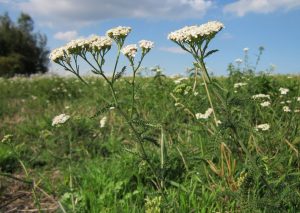
|
YarrowHeight: 0.5 m
Yarrow is a small perennial wildflower species that can grow up to 0.5 m in height. The leaves are dark green coloured, pinnately compound, aromatic when crushed, and are feather-shaped, resembling a fern. The flowers are small, creamy white coloured, have yellow honeycomb centers, appear in wide clusters, and bloom between June and September. This flower blooms for long periods. This wildflower spreads well and can be used to naturalize un-vegetated areas.
|
Compartment A
Naturalization Area
Deer and erosion issues pH: acidic
pH: acidic Depth: potted
Depth: potted-
 Moisture: moist
Moisture: moist -
 Soil Type: sandy, loamy
Soil Type: sandy, loamy -
 Light conditions: partial sun, shade
Light conditions: partial sun, shade
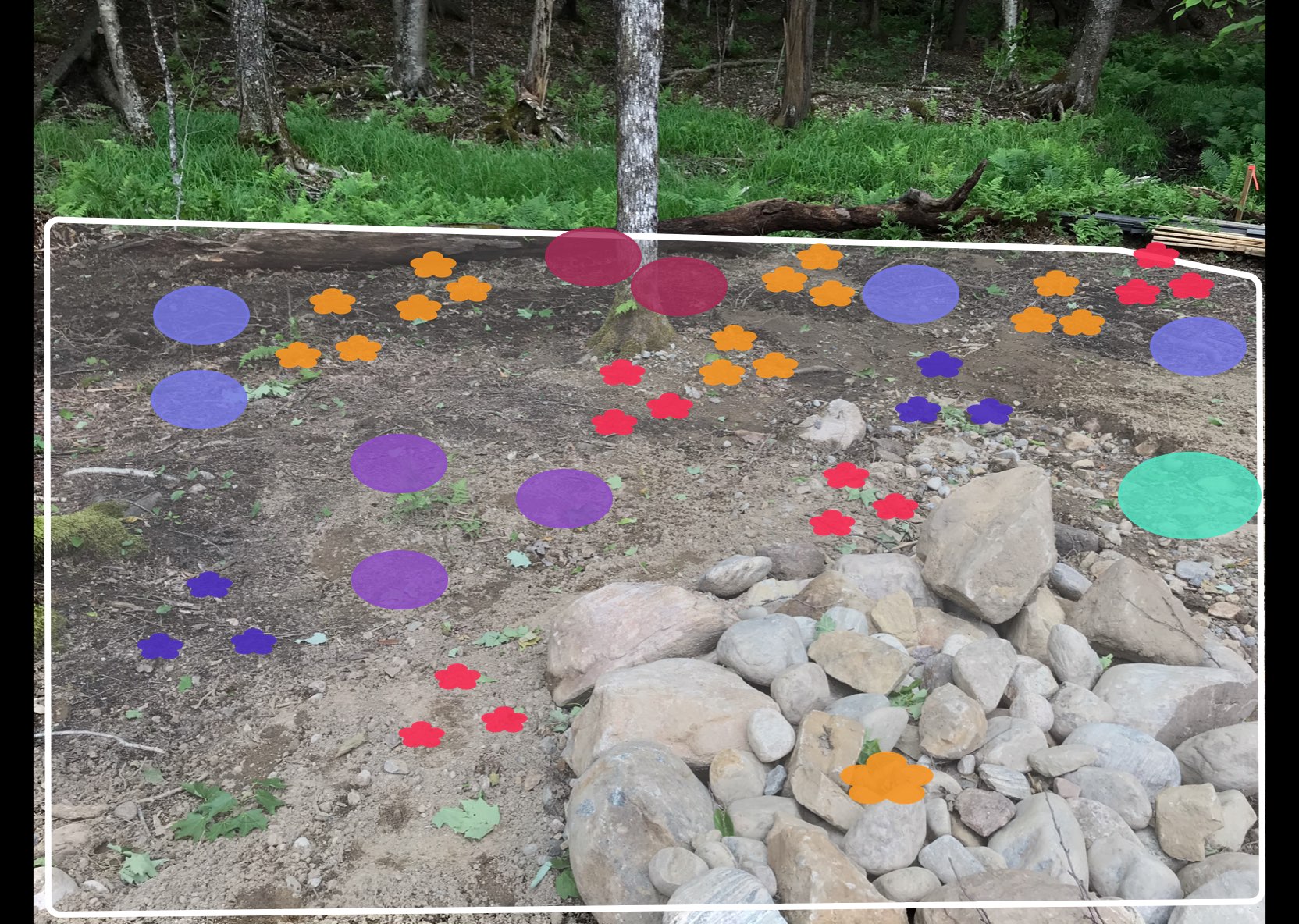
Compartment B
Naturalization Area
Deer issues pH: acidic
pH: acidic Depth: potted
Depth: potted-
 Moisture: normal
Moisture: normal -
 Soil Type: sandy
Soil Type: sandy -
 Light conditions: partial sun
Light conditions: partial sun
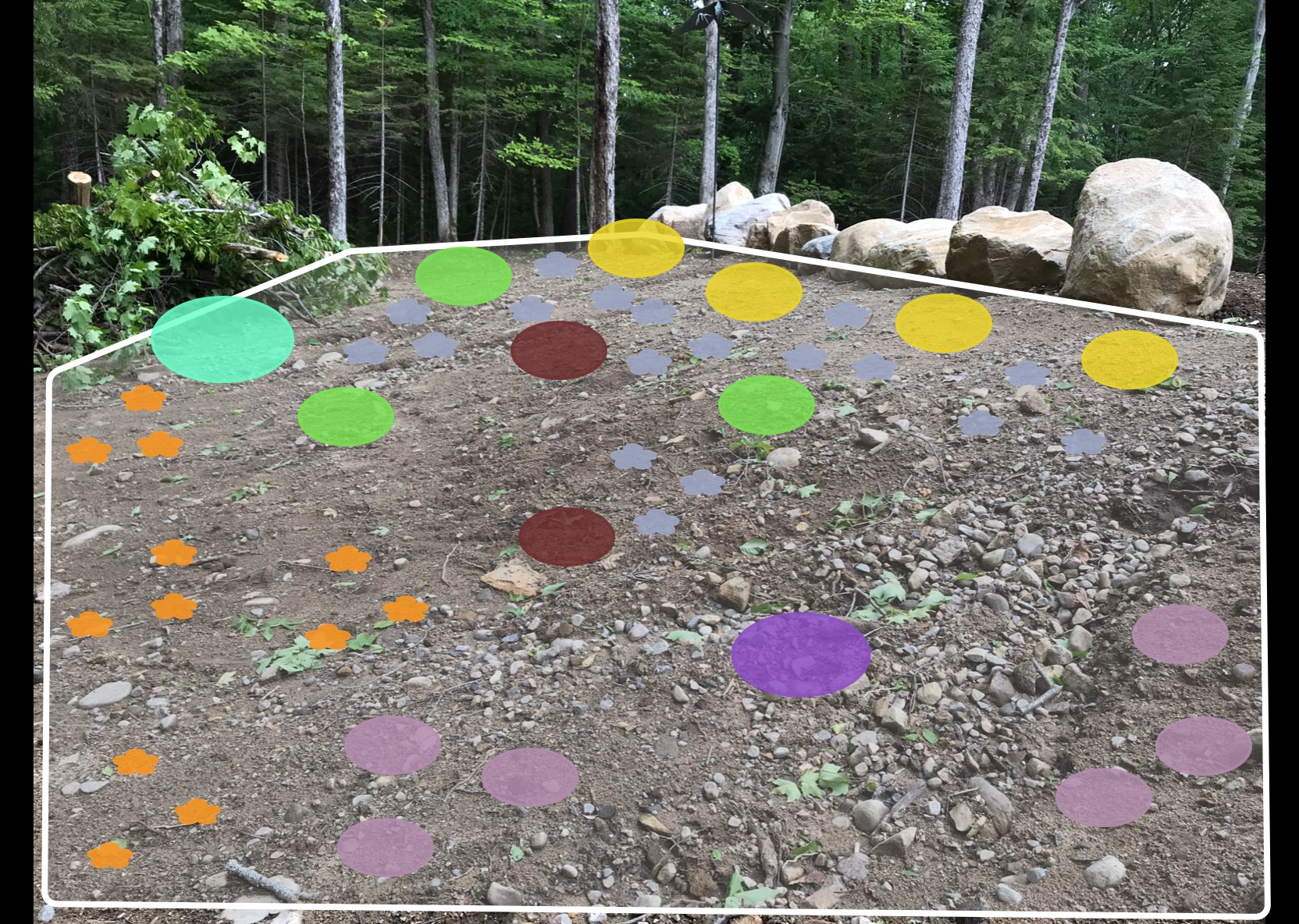
Compartment C
Naturalization Area
Deer issues pH: acidic
pH: acidic Depth: potted
Depth: potted-
 Moisture: normal
Moisture: normal -
 Soil Type: sandy
Soil Type: sandy  Plant Height: max 2m
Plant Height: max 2m-
 Light conditions: partial sun
Light conditions: partial sun
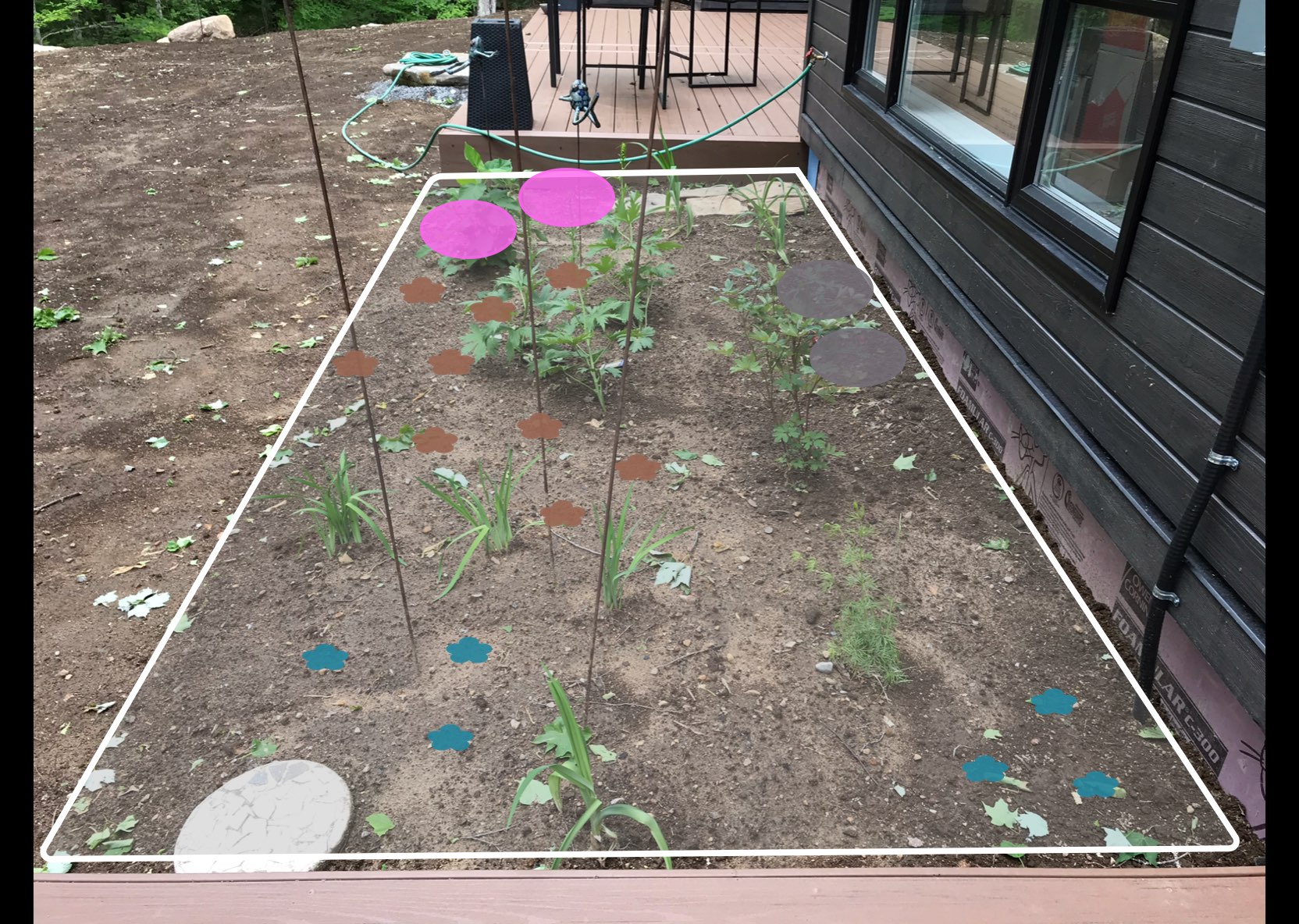
Compartment D
Naturalization Area
Deer issues pH: acidic
pH: acidic Depth: potted
Depth: potted-
 Moisture: normal
Moisture: normal -
 Soil Type: sandy, loamy
Soil Type: sandy, loamy  Plant Height: max 2m
Plant Height: max 2m-
 Light conditions: partial sun, shade
Light conditions: partial sun, shade
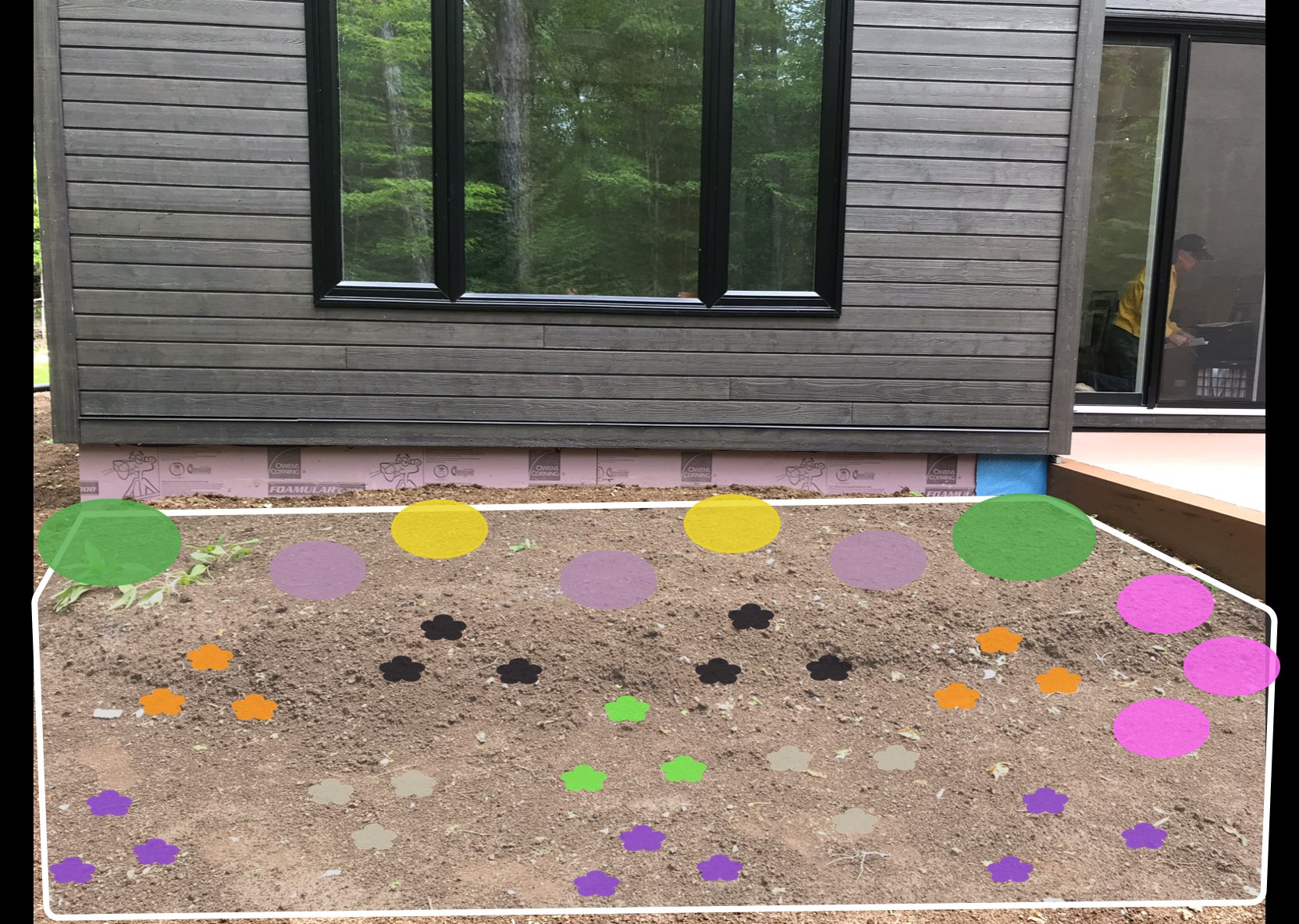
Compartment E
Naturalization Area
Deer issues pH: acidic
pH: acidic Depth: potted
Depth: potted-
 Moisture: normal
Moisture: normal -
 Soil Type: sandy
Soil Type: sandy  Plant Height: max 3m
Plant Height: max 3m-
 Light conditions: partial sun
Light conditions: partial sun
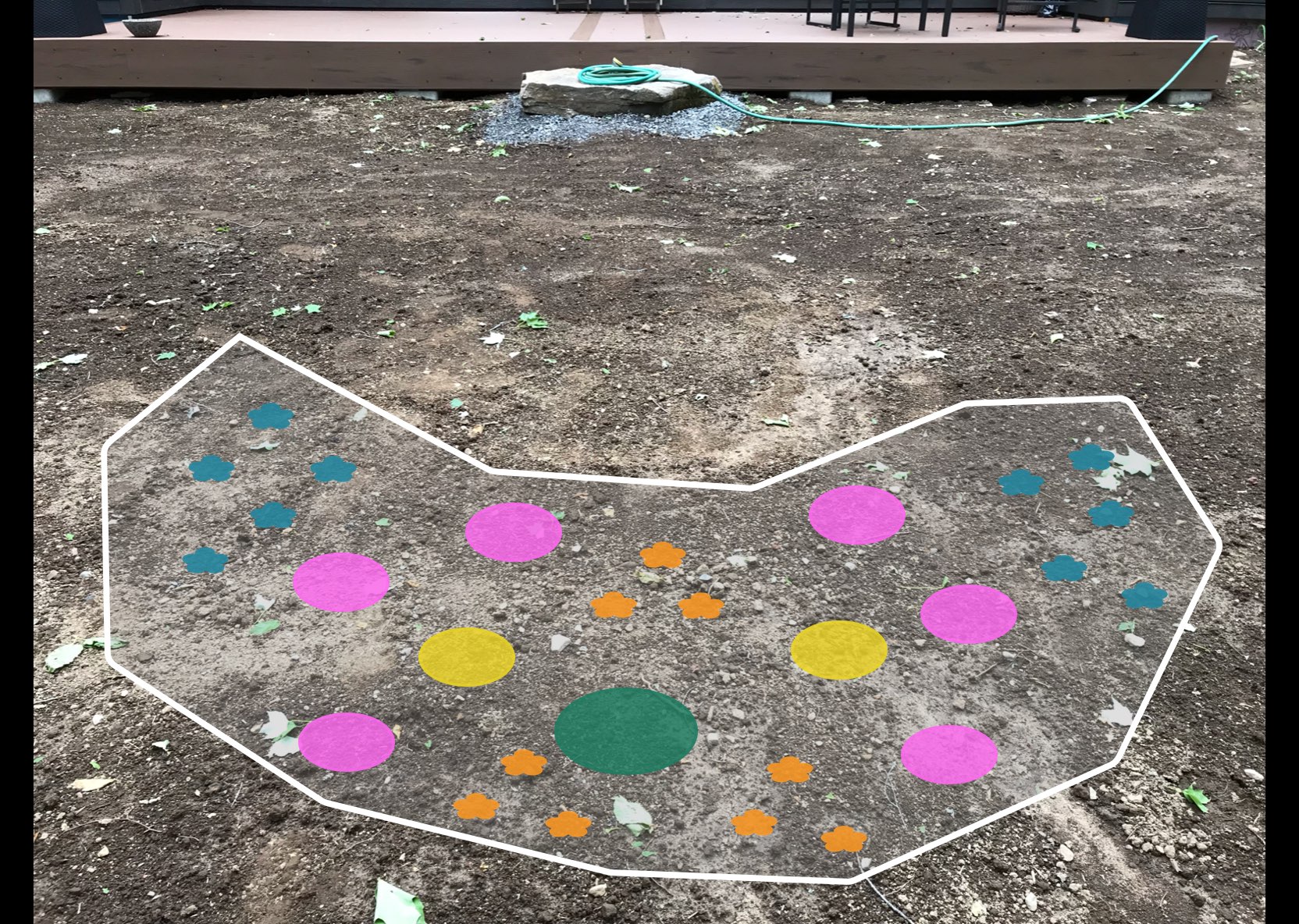
Compartment F
Naturalization Area
Deer issues pH: acidic
pH: acidic Depth: potted
Depth: potted-
 Moisture: normal, moist
Moisture: normal, moist -
 Soil Type: sandy
Soil Type: sandy -
 Light conditions: full sun
Light conditions: full sun
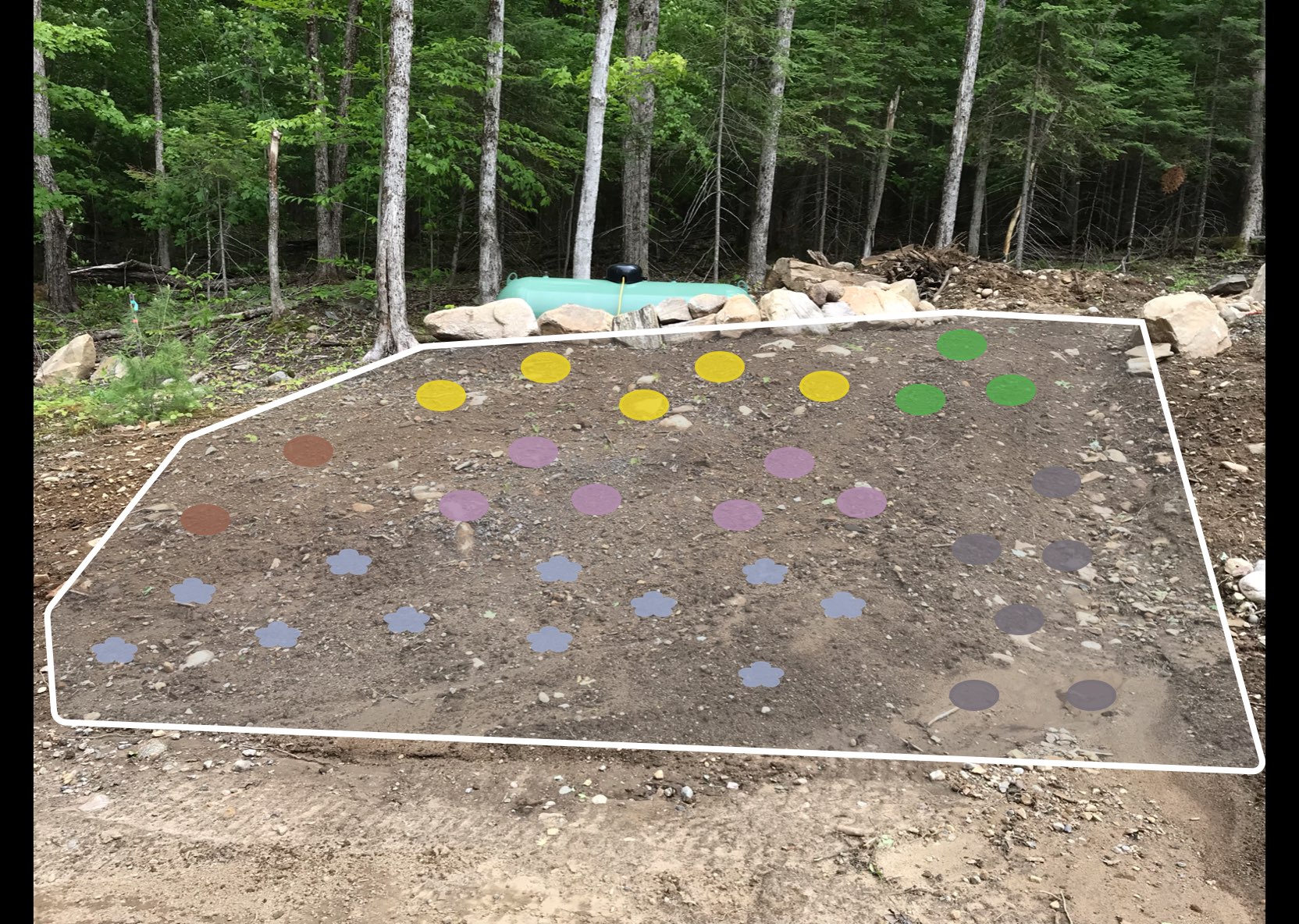
Compartment G
Naturalization Area
Deer issues Grow Me Instead guide pH: acidic
pH: acidic Depth: potted
Depth: potted-
 Moisture: normal
Moisture: normal -
 Soil Type: sandy
Soil Type: sandy -
 Light conditions: full sun
Light conditions: full sun
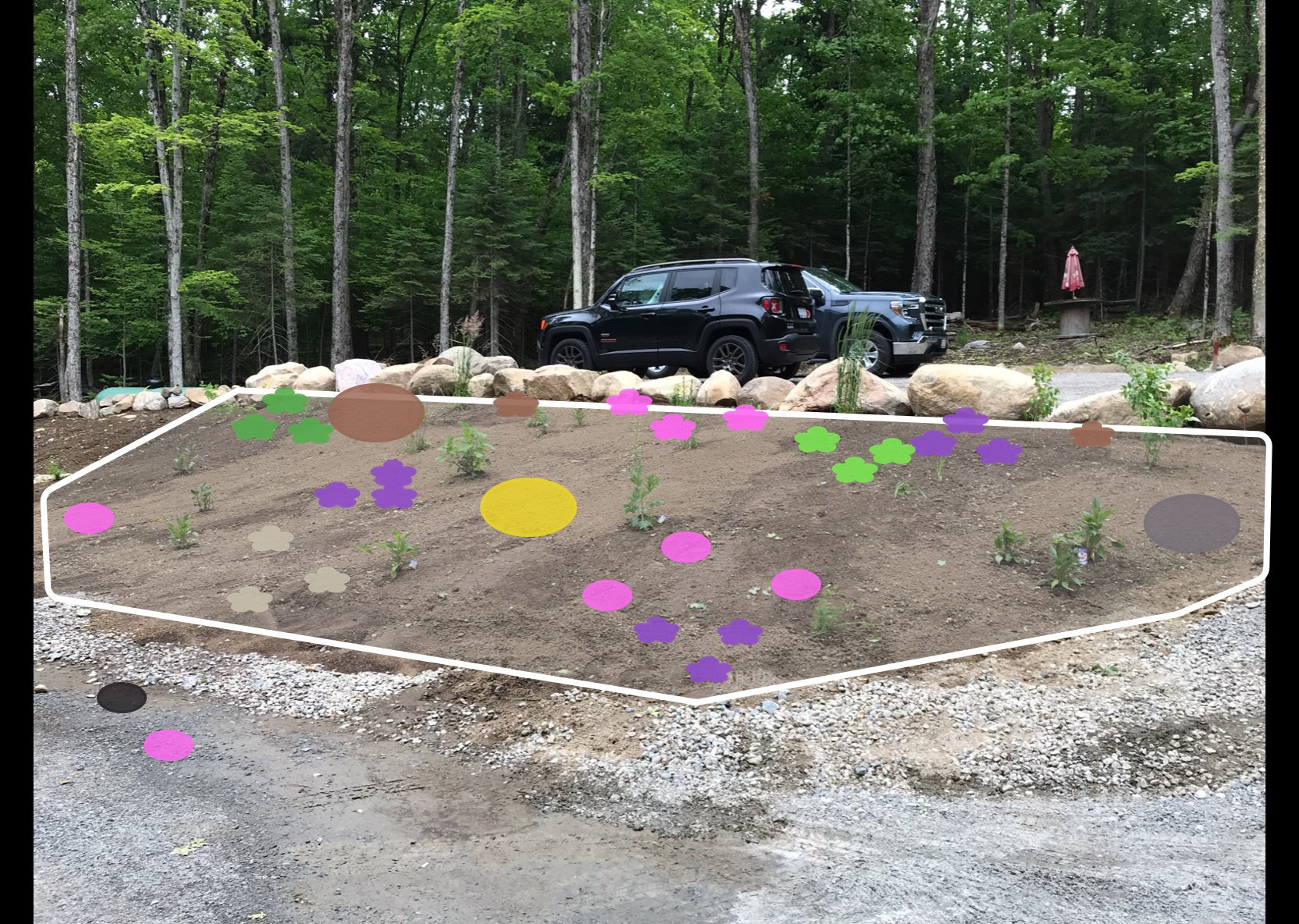
Schedule B
Financial Summary
Project by: The District Municipality of Muskoka
Shoreline Re-Naturalization Starter Kit includes: free site visit, customized re-naturalization planting plan for your shoreline property, native plants including free bare root (small) and potted (large) plants and wildflowers, coconut fibre pads to deter grass from growing around new plantings, tree guards for all deciduous trees, mulch for your wildflowers, Plant Care Guide with instructions on how to take care of your new plants, Habitat Creation Guide and a Wildflower Garden Guide.
Our planting plans are created onsite with you and provide detailed information and plans to re-naturalize your shoreline property. We take photos of areas for planting and overlay native plants that are well suited to your property based on site conditions such as soil type and sunlight availability.
We will work with you to create a plan that works for you including options for low growing plants in areas where views are important.
| Item | Quantity | Cost/Item | Subtotal |
|---|---|---|---|
| Starter Kit fee | $300 | ||
| Free potted plants | 20 | $0 | $0 |
| Paid potted plants | 61 | 12.00 | 732.00 |
| Free bareroot plants | 0 | $0 | $0 |
| Free wildflowers | 30 | $0 | $0 |
| Paid wildflowers | 132 | 6.00 | 792.00 |
| Total costs | 1824.00 |
Schedule C
Project Agreement
Stewardship Agreement
Please indicate your agreement to this proposed plan by signing the following Stewardship Agreement and submitting it, along with your financial contribution, to:
The District Municipality of Muskoka
70 Pine Street
Bracebridge, Ontario
P1L 1N3
Plant Availability
Please note that plant species may need to be changed based on plant stock availability at the time of ordering.
Project Completion
Upon receiving your signed stewardship agreement and financial contribution, a date will be booked for you to pick up your Natural Edge Kit. The District Municipality of Muskoka will supply all plants and materials. If you are paying for the planting to be completed for you, a date will be arranged for The District Municipality of Muskoka to plant your shoreline, bringing the plants and materials with them. If there are particular dates that you would prefer, we will do our best to accommodate your requests.
The Natural Edge Stewardship Agreement with The District Municipality of Muskoka
Agreement made this 15th Day of the Month of June in the Year 2020.
BETWEEN George Nickerson 1135 North Portage Road Ontario P1H 2J6 (Hereinafter called the OWNERS)
AND The District Municipality of Muskoka 70 Pine Street Bracebridge, Ontario P1L 1N3 (Hereinafter called DMM)
WHEREAS the Owners and DMM have met and discussed plans for shoreline naturalization on the specified area(s) in Schedule A existing on the Owners’ land;
WHEREAS the Owners indicate approval of the project as proposed; and
WHEREAS the project is, or will be for the benefit of the Owners and others;
NOW THEREFORE THE PARTIES AGREE AS FOLLOWS:
1. This Agreement shall be in effect for a period of 5 years, commencing with the date of this Agreement.
2. The Owners and DMM agree that the areas where the work is to be performed is as described in Schedule A.
3. The Owners agree to pick up their Natural Edge Starter Kit from DMM’s office and plant their shoreline within two days of receipt. The Owners will provide “after” photos of the work completed to be used for reporting purposes. If the Owners wish to have the planting completed for them, then DMM or it’s contractors, employees and agents will complete the planting at cost, as indicated in Schedule B.
4. If the planting is to be completed by DMM, then the Owners grant DMM, its contractors, employees and agents, the right to enter the property to perform the work agreed upon as outlined in Schedule A. In addition, DMM, its contractors, employees and agents may inspect the work performed for the purposes of monitoring the project and survival assessment, with prior agreement with Owners for date and time of inspection.
5. The Owners agree to contribute the “Landowner contribution” and pay the costs indicated in Schedule B.
6. In instances where the Owners are to pay DMM for work to be performed (outlined in Schedule A), the Owners agree to provide payments to DMM prior to the commencement of that operation. Failure of payment shall constitute a breach of this Agreement and the Owners agree that this Agreement will be terminated and thereupon the Owners agree to pay DMM the estimated costs of the operations of the project completed to date, if any.
7. The Owners agree, if necessary, to perform a reasonable amount of maintenance, which is described in the Native Plant Care Guide, available at naturaledge.watersheds.ca.
8. If a contractor is required to perform the work outlined in Schedule A, then the contractor carrying out the work on the land described will be required to take out and furnish evidence of a comprehensive policy of public liability and property damage coverage. The contractor and their workers will be required to be in good standing with the Workplace Safety and Insurance Board (WSIB) prior to performing the work.
9. The Owners agree not to remove, destroy or alter the project without prior consultation and approval of DMM. Pruning and trimming planted nursery stock, or adding replacement native nursery stock is exempt.
10. The Owners agree not to mow the planted area.
11. The Owners do acknowledge that DMM, its contractors, employees and agents, having performed said works, are not under further obligation with respect to survival of nursery stock, inspection, or maintenance.
12. The Owners, in the absence of negligence, hereby remise, release and forever discharge DMM, its contractors, employees and agents from all claims and demands for injuries, including death, loss, damages and costs in any way related to or connected with installation and maintenance of the work described or resulting from any deleterious effects of the work to the land or to the lands and buildings thereon retained by the Owners.
IN WITNESS WHEREOF the parties have agreed to the contents of this plan; SIGNED:
About this program
About The District Municipality of Muskoka
The District of Muskoka is an upper-tier municipality that has monitored water quality in Muskoka area lakes since 1980. Since 2002, the Muskoka Water Strategy has provided integrated and strategic initiatives for the protection of Muskoka's water resources. The purpose of the strategy is to guide and minimize the impact of human activities on water resources; ensure human and environmental health; and preserve the quality of life in Muskoka.
This program was created by Watersheds Canada
We believe that every person has the right to access clean and healthy lakes and rivers in Canada. At Watersheds Canada, we work to keep these precious places naturally clean and healthy for people and wildlife to continue using for years to come. We love working with others to meet the needs of local communities, whether you’re a concerned citizen, a landowner, a lake association looking for help, or a coalition of groups interested in activating your local community.

